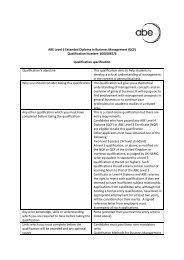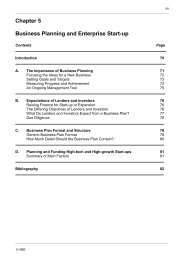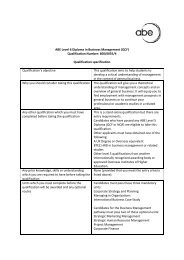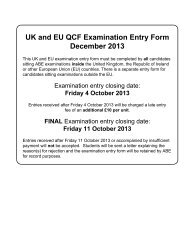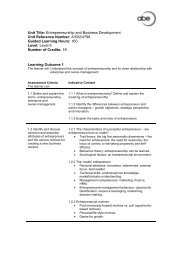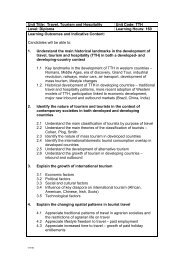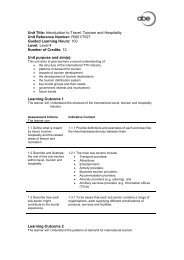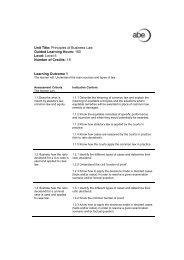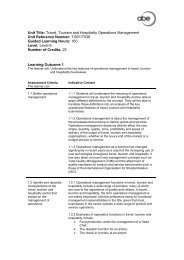Unit Title: Corporate Strategy and Planning Unit Code: SM Level: 6 ...
Unit Title: Corporate Strategy and Planning Unit Code: SM Level: 6 ...
Unit Title: Corporate Strategy and Planning Unit Code: SM Level: 6 ...
- No tags were found...
Create successful ePaper yourself
Turn your PDF publications into a flip-book with our unique Google optimized e-Paper software.
<strong>Unit</strong> <strong>Title</strong>: <strong>Corporate</strong> <strong>Strategy</strong> <strong>and</strong> <strong>Planning</strong> <strong>Unit</strong> <strong>Code</strong>: <strong>SM</strong><strong>Level</strong>: 6 Learning Hours: 210Learning Outcomes <strong>and</strong> Indicative Content:C<strong>and</strong>idates will be able to:1. Critically evaluate the nature, scope <strong>and</strong> need for systematiccorporate strategic planning1.1 Describe <strong>and</strong> explain the growth, advantages, <strong>and</strong> limitations ofsystematic corporate strategic planning1.2 Compare <strong>and</strong> contrast the different models <strong>and</strong> patterns ofstrategy development1.3 Examine the different levels of strategy <strong>and</strong> the characteristicsof strategic as compared to tactical decisions <strong>and</strong> management1.4 Describe <strong>and</strong> explain with the key elements /steps in thecorporate strategic planning process1.5 Analyse <strong>and</strong> assess the corporate planning process in differentorganisational contexts2. Assess the scope, uses <strong>and</strong> techniques of analysis for corporatestrategic planning2.1 Examine the scope, importance <strong>and</strong> uses of analysis incorporate strategy: Strategic Fit <strong>and</strong> SWOT2.2 Examine the scope, uses <strong>and</strong> techniques of macroenvironmental analysis –The PESTEL framework; scanning <strong>and</strong>forecasting2.3 Examine the scope, uses <strong>and</strong> techniques of market <strong>and</strong>customer analysis2.4 Examine the scope, uses <strong>and</strong> techniques of competitor analysis2.5 Examine the scope, uses <strong>and</strong> techniques of internal(company) analysis2.6 Examine techniques of portfolio analysis <strong>and</strong> planning3. Identify, consider <strong>and</strong> assess strategic options <strong>and</strong> decisions3.1 Describe <strong>and</strong> explain the range, nature <strong>and</strong> inputs tosetting corporate objectives <strong>and</strong> goals3.2 Evaluate ‘mission’, ‘vision’ <strong>and</strong> ‘strategic intent’ statements3.3 Explain <strong>and</strong> evaluate the concepts of ‘strategic stubbornness’<strong>and</strong> ‘strategic drift’3.4 Evaluate Profit vs. other primary corporate objectives3.5 Examine ‘gap analysis’ in setting objectives3.6 Identify <strong>and</strong> assess strategies for competitive advantage3.7 Identify <strong>and</strong> assess strategies for growth: directions <strong>and</strong>methods3.8 Identify <strong>and</strong> assess strategies for mature <strong>and</strong> declining markets3.9 Identify <strong>and</strong> assess strategies for different market positions
4. Evaluate <strong>and</strong> decide between strategic options4.1 Explain the use ideas <strong>and</strong> concepts related to the decisionmaking process4.2 Examine the frameworks, concepts <strong>and</strong> criteria for evaluating<strong>and</strong> selecting strategies4.3 Identify <strong>and</strong> assess techniques of strategy appraisal <strong>and</strong>decision making including decision trees <strong>and</strong> the PIMS database5. Make recommendations with regard to implementing strategies<strong>and</strong> measuring <strong>and</strong> controlling corporate strategic performance5.1 Examine the concept of ‘strategic architecture’ inimplementing strategies5.2 Examine the links between corporate strategies <strong>and</strong>organisational structure5.3 Explain the concept <strong>and</strong> use of Strategic Business <strong>Unit</strong>s(SBU) structures5.4 Explain the importance <strong>and</strong> nature of resource allocation<strong>and</strong> budgeting5.5 Assess human resource issues in implementingcorporate strategic plans5.6 Assess the issues in planning <strong>and</strong> managing change5.7 Identify <strong>and</strong> examine the issues in, <strong>and</strong> techniques available formeasuring <strong>and</strong> controlling corporate strategic performance5.8 Examine <strong>and</strong> evaluate the role <strong>and</strong> importance of managementinformation <strong>and</strong> decision support systems in evaluation <strong>and</strong>control6. Identify <strong>and</strong> critically evaluate key contemporary issues <strong>and</strong>future challenges affecting corporate strategic planning6.1 Examine global influences <strong>and</strong> aspects of corporatestrategic planning6.2 Examine corporate strategy in innovative <strong>and</strong>entrepreneurial organisations6.3 Examine <strong>and</strong> discuss social <strong>and</strong> ethical issues in corporatestrategy6.4 Examine <strong>and</strong> discuss corporate governance <strong>and</strong>stakeholder concepts of businessAssessment Criteria:• Assessment method: written examination• Length of examination: three hours• C<strong>and</strong>idates should answer four questions from a choice of eight, eachquestion carrying equal marks
Recommended ReadingABE, ABE Study Manual – <strong>Corporate</strong> <strong>Strategy</strong>, ABEJohnson G, Scholes K, Exploring <strong>Corporate</strong> <strong>Strategy</strong> (2004), Pearson HigherEducationISBN: 0273687395Haberberg A, Rieple A, The Strategic Management of Organisations (2001),Pearson Higher EducationISBN: 0130219711





